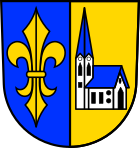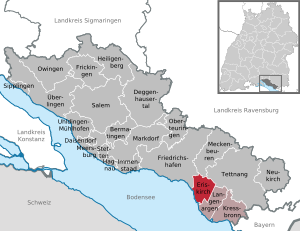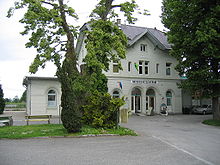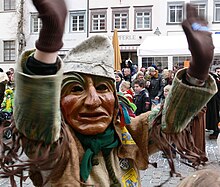Eriskirch
| coat of arms | Germany map | |
|---|---|---|

|
Coordinates: 47 ° 38 ' N , 9 ° 32' E |
|
| Basic data | ||
| State : | Baden-Württemberg | |
| Administrative region : | Tübingen | |
| County : | Lake Constance district | |
| Height : | 400 m above sea level NHN | |
| Area : | 14.58 km 2 | |
| Residents: | 4908 (December 31, 2018) | |
| Population density : | 337 inhabitants per km 2 | |
| Postal code : | 88097 | |
| Area code : | 07541 | |
| License plate : | FN, TT, ÜB | |
| Community key : | 08 4 35 013 | |
| LOCODE : | DE ERI | |
| Address of the municipal administration: |
Schussenstrasse 18 88097 Eriskirch |
|
| Website : | ||
| Mayor : | Arman Aigner ( independent ) | |
| Location of the municipality of Eriskirch in the Lake Constance district | ||
Eriskirch is a municipality in Baden-Württemberg on Lake Constance , roughly halfway between Friedrichshafen and Langenargen and seven kilometers south of Tettnang .
geography
The municipality is located at the mouth of Schussen and is characterized by extensive forest areas as well as through the largest nature reserve on the northern shores of Lake Constance, the 550 hectares large Eriskircher Ried .
Community structure
The municipality of Eriskirch includes the suburbs Eriskirch , Mariabrunn , Schussenreute, Röcken, Ziegelhaus, Knöbelhof, Wolfzennen, Langenacker, Hofstatt, Braitenrain and Dillmannshof (since the municipal reform in 1937), Schlatt , Gmünd, Moos and Ober- and Unterbaumgarten (since 1818) .
climate
The average annual air temperature is 9 ° C, the average amount of precipitation 950 to 1000 mm per year, there is a favorable climate for fruit and hops cultivation.
|
Monthly mean values for Eriskirch-Mariabrunn, 1961 to 1990
Source: DWD Climate Data Germany
|
||||||||||||||||||||||||||||||||||||||||||||||||||||||||||||||||||||||||||||||||||||||||||
history

As in other places in the Lake Constance region, archaeological finds have already proven settlements from the Stone Age . Around 50 AD the Romans built a bridge over the Schussen here. The associated Roman settlement on the western bank of the Schussen, the Roman vicus of Eriskirch, is largely unexplored .
The first secure documentary mention of Eriskirch dates back to 1257. Until 1472 the Baumgarten dominion belonged to the Constance Monastery . The Eriskircher farmers put up bitter resistance to the sale to the Free Imperial City of Buchhorn (today Friedrichshafen ).
At the end of the 14th century, the early Gothic Church of the Assumption of Mary was rebuilt after Eriskirch had developed into a well-known place of pilgrimage . The rich furnishings with works by the master of Eriskirch, the glass windows and Gothic wall paintings (each around 1420) - the “Poor Bible” and the “Host Mill” are almost completely preserved in the fully painted choir - testify to a flourishing pilgrimage up to the 19th century. The bells V, VI and I from the 13th, 14th and 16th centuries can be heard from this time until today. After the Thirty Years War , the building was partially redesigned in Baroque style in 1666, in particular the wall paintings were whitewashed and the roof of the nave was raised by about two meters to the ridge height of the choir. The statues of the apostles also date from this period. In 1933 the Gothic wall paintings were brought out again.
The Count of Montfort donated, among other things, the "founder window" in the Sanctuary "Assumption" around 1420 in Eriskirch and in today's district Mariabrunn in the 18th century, the church "To our dear wife."
In the 19th century Eriskirch first fell to Bavaria , then in 1810 to Württemberg on the basis of the border treaty and was assigned to the Tettnang District Office. The community experienced an economic boom when it was connected to the rail network of the Württemberg State Railways and the neighboring Bavarian State Railways in 1899 via the Friedrichshafen – Lindau railway line .
The administrative reform during the Nazi era in Württemberg led in 1938 to membership of the Friedrichshafen district , which continued to exist as the Tettnang district after the war. Eriskirch had been in the French occupation zone since 1945 and thus came to the newly founded state of Württemberg-Hohenzollern , which was incorporated into the state of Baden-Württemberg in 1952. Due to the district reform in Baden-Württemberg , Eriskirch became part of the Lake Constance district in 1973 .
The remains of Baumgarten Castle are in the Oberbaumgarten district .
Religions
A separate parish has been recorded since 1353. The present suburb of Mariabrunn has also been a parish since 1823. Even today, the place is predominantly Roman Catholic . In the 750th anniversary year 2007, two new bells ( Francis and Benedict XVI. ) Were donated for the Eriskircher Church of the Assumption of Mary . Both bells were blessed by Bishop Gebhard Fürst as part of a star pilgrimage on April 29, 2007. On May 6, 2007, over 200 children and adults from the community together with Auxiliary Bishop Bernhard Rieger and Mayor Markus Spieth pulled the bells into the tower by hand.
The 800 Protestant Christians in the community (as of 2004) belong to the Langenargen-Eriskirch parish in the Ravensburg church district of the Evangelical Church in Württemberg . In 1970 the Protestant cruciform church was built in the Schlatt district.
Incorporations
- 1818: Upper and Lower Tree Garden
- 1937: Mariabrunn
politics
Administrative association
Eriskirch has merged with the communities of Langenargen and Kressbronn to form a community administration association.
mayor
In the mayoral election on April 5, 2009, Markus Spieth (independent) was confirmed for a third term of office with 79.11% of the validly cast votes and a voter turnout of 64.72%.
In the mayoral election on April 9, 2017, Arman Aigner (independent) was elected mayor with 51.7%. The turnout was 59.3%.
Municipal council
In the local elections on May 26, 2019 , the distribution of seats was as follows:
| CDU | 44.5% | −7.2% | 6 seats | −1 |
| Free Electoral Association Eriskirch (FWV) | 55.5% | + 7.2% | 8 seats | +1 |
coat of arms
Blazon : "Split of blue and gold, in front a golden lily ( Iris sibirica ), behind a blue roofed silver church in perspective view with a right-hand bell tower integrated into the nave with a pointed rhombic roof and black portal on the left front side."
The coat of arms of Eriskirch is a talking coat of arms , as it alludes to the place name: "Iris" and "Church" result in "Eriskirch".
Community partnerships
- Nerchau , Saxony
- Egnach , Thurgau / Switzerland
Economy and Infrastructure
Eriskirch mainly serves as a residential community for people who work in the surrounding larger cities such as Friedrichshafen. The headquarters of the mechanical engineering company DRIAM Anlagenbau , the world market leader in the field of large coaters for coating tablets and dragees, is located in Eriskirch itself .
In addition, the community has retained an agricultural character to this day, with fruit and hops growing in particular . After all, tourism is also important in the "state-approved resort" .
The energy supply is provided by the regional plant in Lake Constance .
traffic
Eriskirch is located on federal highway 31 and is also connected to the railway network by the Friedrichshafen – Lindau railway line.
The community is also with some bus routes u. a. connected with Friedrichshafen , Tettnang and Langenargen and belongs to the Bodensee-Oberschwaben Verkehrsverbund ( bodo ).
For regional airport Friedrichshafen it's five kilometers.
In addition, the Lake Constance cycle path and circular route lead through the Eriskirch, which is located directly on the eponymous body of water.
Culture and sights
Eriskirch is on the main route of the Upper Swabian Baroque Road .
Conservation Center
Eriskirch offers a nature conservation center that specializes in the flora and fauna and nature conservation of the nearby vineyard. In particular, the exhibitions on the topic of nature on Lake Constance, but also the guided tours through the 450 hectare Eriskircher Ried , the largest nature reserve on the northern shore of Lake Constance, are worth seeing. The reed was designated as a nature reserve as early as 1937. The population of the blue flowering Siberian iris is the largest of its kind in Germany. Despite earlier floods and the occasional use of the reed as a military training area, the entire area is now in good ecological condition again.
Buildings
- In the pilgrimage church Maria Himmelfahrt , which was built around 1400, rare Secco paintings can be seen in the high Gothic choir room. These wall paintings were created between 1420 and 1430. In the choir of the sacred building, which is now used as a parish church, there are still two stained glass windows that were donated by the Counts of Montfort . A special treasure is the miraculous image of the Mother of God with Christ, enthroned on the base with a moon face from the year 1350. The image of the depiction of a wafer mill as a mural painting is also unique . On the south wall of the nave there is - as in the Jodokus Church in Überlingen - a mural with the legend of the meeting of the three living and the three dead from around 1430. As a special feature, the left group of the living is separated from the right group of the Dead separated by a half-length portrait of Christ as the judge of the world over two open graves, from which two dead people emerge and hold tapes whose texts can no longer be deciphered.
- Two historic wooden bridges lead over the Schussen: one from 1828 near the town center and one built in 1824 in the Oberbaumgarten district. The Eriskircher Bridge rests on 96 wooden piles that were driven on February 13, 1828; it has since formed the connection from Oberdorf to Eriskirch on the former border between the imperial city of Buchhorn and the county of Montfort .
Regular events
- Swabian-Alemannic carnival with the fools' guild "Streibemahder", the "Schussenhexen" and the "Lumpenkapelle Eriskirch".
Personalities
Honorary citizen
- Ernst Zodel, because of his services to maintaining the independence of the community and his commitment to local politics.
Sons and daughters of the church
- Carl Lehle (1872–1939), rower
- Josef Wund (1938–2017), architect and entrepreneur; born in Mariabrunn
literature
- Johann Daniel Georg von Memminger: Municipality of Eriskirch , in: Description of the Oberamt Tettnang . Cotta, Stuttgart and Tübingen 1838 ( full text at Wikisource )
- Eriskirch parish (ed.): 750 years Eriskirch. Contributions to history and outlook for the 21st century . Eriskirch parish, Eriskirch 2006, ISBN 978-3-88812-208-8
Web links
Individual evidence
- ↑ State Statistical Office Baden-Württemberg - Population by nationality and gender on December 31, 2018 (CSV file) ( help on this ).
- ↑ http://www.dwd.de/bvbw/appmanager/bvbw/dwdwwwDesktop?_nfpb=true&_windowLabel=T3200039671164966383319&_state=maximized&_pageLabel=dwdwww_start
- ↑ State Gazette No. 13 of April 9, 2009, page 10
- ↑ http://www.suedkurier.de/region/bodenseekreis-oberschwaben/eriskirch/Arman-Aigner-wird-Buergermeister-von-Eriskirch;art372472,9211404
- ↑ a b Hikers admire irises. Inzigkofer local group of the Swabian Alb Association in the Eriskircher Ried on Lake Constance . In: Südkurier from June 6, 2009
- ↑ Hans Georg Wehrens: The dance of death in the Alemannic language area. "I have to do it - and don't know what" . Schnell & Steiner, Regensburg 2012, ISBN 978-3-7954-2563-0 . P. 34.
- ↑ Ralf Schäfer: History in the entablature - The historic Schussenbrücke in Eriskirch in "40 Years of Lake Constance District", special publication of the Schwäbische Zeitung, page 15, September 28, 2013










